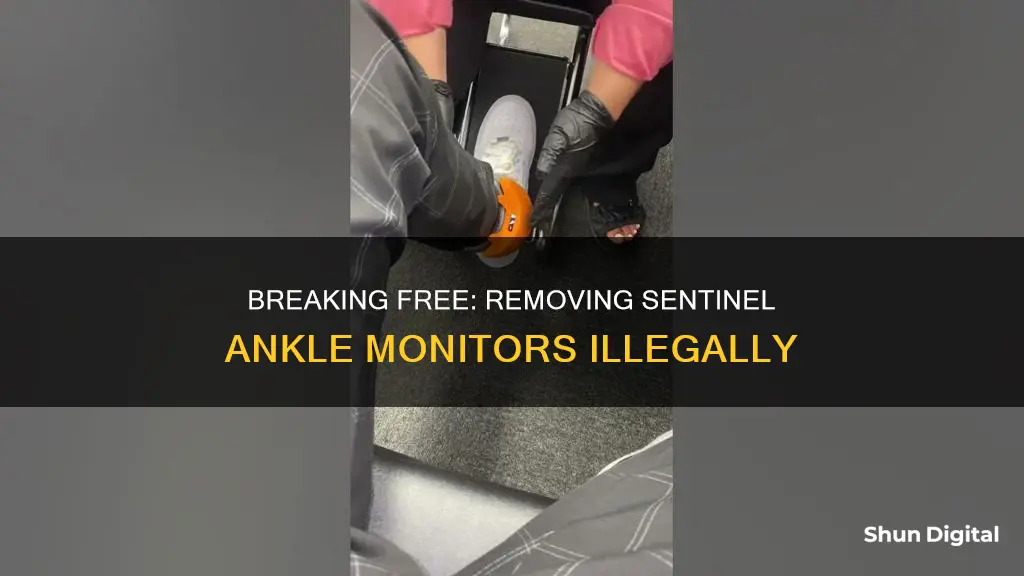
Ankle monitors are a source of great stress and distraction for those forced to wear them. While it may be tempting to cut off the strap or disassemble the device, this is not the correct way to remove an ankle monitor. The proper way to remove an ankle monitor is to submit an official request to the court. This article will outline the steps to legally remove an ankle monitor, including creating a motion document, setting a hearing date, and presenting your argument in court.
| Characteristics | Values |
|---|---|
| Legality | It is possible to legally remove a Sentinel ankle monitor by submitting an official request to the court. |
| Process | Submit a motion, or a request for a change of order, to the court. Consult with a legal attorney to increase the chances of the request being granted. |
| Reasons | Examples of legitimate reasons for removal include job-related requirements or conflicts, medical attention, severe ankle pain or injury, mental stress and distraction. |
| Supervision officer | Communicate and attempt to get the supervision officer on your side. Their recommendation may influence the judge's decision. |
| Motion document | Include caption information, the title and body of the motion, case background, and reasons for removal. Close with a conclusion and include a certificate of service. |
| Order | A signature is required on an "Order" document for the judge to grant the request. |
| Hearing | Schedule a hearing date and submit the motion to the court. Arrive early, dress appropriately, and bring all required documents. |
| Argument | State your argument clearly and precisely, addressing the judge respectfully. |
| Decision | The judge will consider all aspects of the case and make a decision. Remain calm and respectful, regardless of the outcome. |
What You'll Learn

Submit an official request to the court
To remove a Sentinel ankle monitor, you must submit an official request, known as a motion, to the court. This is a formal request asking the court to modify your conditions, such as probation, parole, or bail, by removing the ankle monitor. Here is a step-by-step guide on how to submit an official request to the court:
- Have a legitimate reason for removing the ankle monitor: Examples of valid reasons include job-related requirements or restrictions, medical needs, severe ankle pain or injury, mental distress, or the need for specific medical procedures such as an MRI, CT-scan, or X-ray. While you can still request removal without a reason, providing a valid justification increases the likelihood of your request being granted.
- Communicate with your supervision officer: It is advisable to have your supervision officer on your side. Explain your reasons for wanting to remove the ankle monitor, as their recommendation to the judge can influence the outcome. Maintain a positive relationship and ensure you haven't violated any restrictions prior to making your request.
- Create a motion document: This is a formal written request addressed to the court. Consult with an attorney to ensure your motion adheres to the specific rules, protocols, and wording requirements of the court. The motion document should include the following:
- Caption information: Provide the name of the Court, the Plaintiff or Prosecutor, and the Defendant.
- Title and body of the motion: Title your motion to reflect your situation, such as "Motion to Modify Probation/Parole/Bail." In the body, introduce yourself and explain that you are representing yourself. Clearly state your request to have the ankle monitor removed.
- Case background and facts: Provide details about your case, including the starting date, the reason for the ankle monitor, and the length of the condition set by the court.
- Arguments and justification: Explain why the ankle monitor should be removed, citing valid reasons and any positive behaviours or improvements in your life. Mention your compliance with all court orders, such as adhering to curfew and paying court fees. If your supervision officer supports your request, be sure to include this information as well.
- Conclusion: Restate your request for ankle monitor removal and include a date and your signature.
- Include a certificate of service: Ensure you send a copy of your motion to both your prosecutor and your supervision officer. Include a statement at the end of your motion or on a separate page, certifying that you have provided copies to the relevant parties.
- Define the proposed order: Compose an "Order" document to accompany your motion. This document should include the caption information and a statement such as, "Hearing held on the motion at [Date of the hearing], the Court finds good cause and it is hereby ORDERED that the Defendant's [Title of the motion] is GRANTED." Leave a signature line at the bottom for the judge.
- Make multiple copies of your motion document: Keep physical copies of your motion document, in addition to digital files. You will need to send copies to your supervision officer and prosecutor, and the court may also request multiple copies. Having extra copies ensures you are prepared for the hearing.
- Set a hearing date: Schedule a hearing date before submitting your motion. Each court has its own procedures, so consult with court staff or your attorney on how to schedule the hearing. Typically, you will need to submit a form known as a "Notice of Hearing," which includes the date, time, and location of the hearing.
- Submit your motion to the court: Once the hearing is scheduled, bring the original motion document and several copies to the court. There may be a filing fee, and the court staff will review and approve your motion by applying an approval stamp.
- Send copies to the prosecutor and supervision officer: While this step is optional, it is respectful and ensures all parties are aware of your request. Consult with your attorney for advice on contacting these individuals.
- Attend the court hearing: Arrive at the court early, dress appropriately, and bring all required documents, including your case documents and compliance records related to your ankle monitor condition.
- State your argument: During the hearing, clearly and confidently present your argument to the judge. Introduce yourself, state your name, and represent yourself. Stick to the points mentioned in your motion and remain calm and respectful.
- Receive the decision: The judge will consider all aspects of your case and the input from the prosecutor and supervision officer. If your request is granted, congratulations! You will then coordinate with your supervision officer to have the ankle monitor removed. If your request is denied, remain calm and respectful, as your behaviour will leave an impression on those involved in your case.
Remember, while you can submit a motion on your own, consulting with an attorney can improve your chances of a successful outcome and guide you through the legal process.
Troubleshooting Green Lines on Your ASUS Monitor
You may want to see also

Have a legitimate reason for removal
To remove a Sentinel ankle monitor legitimately, you must submit an official request to the court, where a judge will consider your reasoning and make a decision. This process involves several steps, and it is beneficial to consult a legal attorney for guidance. Firstly, you need a legitimate reason for wanting the ankle monitor removed. This reason should be compelling and supported by evidence, as you will need to convince the judge to grant your request. Here are some examples of legitimate reasons that may be considered valid:
- Job-related requirements or restrictions, such as specific clothing requirements, the need to travel frequently, or jobs that involve underwater activities like diving, construction, or welding.
- Medical reasons, including the need for hospitalisation, severe ankle pain or injury, or appointments for medical procedures like MRI, CT-scan, or X-ray.
- Mental health concerns, such as the stress and distraction caused by wearing the ankle monitor, which could be impacting your well-being.
While it is possible to request the removal without providing a reason, having a legitimate justification increases the likelihood of your request being granted. It demonstrates a drive for improvement and achievement, which may be viewed favourably by the judge. Therefore, it is essential to carefully consider your reasoning and be prepared to present a strong argument during the court hearing.
Once you have established your legitimate reason, the next step is to communicate and build a positive relationship with your supervision officer. Explain your concerns and seek their support, as their recommendation can carry weight in court. Even if your supervision officer initially disagrees, remain respectful and thank them for their time. Their support is not mandatory, and ultimately, the decision rests with the judge.
In conclusion, having a legitimate and compelling reason for wanting to remove your Sentinel ankle monitor is a crucial first step in the process of legitimate removal. This reason will form the basis of your argument in court, so ensure it is valid, well-supported, and presented clearly and respectfully throughout your interactions with the relevant authorities.
Monitoring Internet Usage: Comcast's Device-Specific Insights
You may want to see also

Consult with a legal attorney
If you are looking to remove a sentinel ankle monitor, consulting with a legal attorney is highly recommended. They can provide experienced insights and guide you through the process, increasing your chances of a successful outcome. Here are some detailed steps on how to consult with an attorney and navigate the legal process:
Choosing an Attorney
Start by researching and selecting a reputable legal attorney with experience in criminal defense and, more specifically, cases involving ankle monitors. Consider reaching out to your local bar association for referrals or asking for recommendations from friends or family members who have faced similar situations.
Initial Consultation
Schedule an initial consultation with the attorney to discuss your case. During this meeting, be honest and provide all the relevant details about your situation, including the circumstances that led to you being placed on ankle monitoring. Ask about their experience with similar cases and their strategy for helping you achieve a favorable outcome.
Understanding the Legal Process
Your attorney will explain the legal process involved in requesting the removal of your ankle monitor. This typically involves submitting a motion to the court. A motion is a formal request asking the court to modify your conditions. The attorney will guide you through the specific steps, requirements, and protocols for submitting a motion in your jurisdiction.
Building Your Case
Work closely with your attorney to build a strong case for the removal of your ankle monitor. This may involve gathering evidence, such as medical records, employment documents, or character references, to support your request. Your attorney will help you identify legitimate reasons for the removal, such as job-related requirements, medical needs, or mental health concerns.
Communicating with Relevant Parties
Your attorney may communicate and negotiate with the prosecution and your supervision officer on your behalf. They can present your case and argue for the removal of the ankle monitor, highlighting any positive behaviors, compliance with court orders, or other relevant factors. Effective communication between all parties can increase the chances of a favorable outcome.
Preparing for Court
If necessary, your attorney will assist in preparing you for any court appearances related to your motion. They will guide you on what to expect, how to dress, and what documents to bring. They can also provide support and representation during the court hearing, ensuring that your arguments are presented clearly and effectively to the judge.
Remember, while consulting with a legal attorney is highly beneficial, the final decision to grant or deny the removal of your ankle monitor rests with the judge presiding over your case.
Monitoring IO Usage: Linux Tips and Tricks
You may want to see also

Communicate with your supervision officer
Communicating with your probation officer is essential when dealing with ankle monitor requirements. Here are some detailed instructions on how to effectively navigate this process:
First, understand that your probation or parole officer is responsible for supervising your ankle monitor and ensuring your compliance with the court's requirements. They are there to help you navigate this process successfully, so maintaining a respectful and cooperative relationship is crucial.
Schedule regular meetings with your supervision officer and prioritize attendance. These meetings provide an opportunity to discuss any concerns or challenges you may have regarding the ankle monitor. For example, if you feel the monitor is impacting your daily activities or employment, share these concerns and ask for advice on potential accommodations. Officers have some discretion and may be able to adjust your parameters or recommend solutions to the court.
Be transparent and honest throughout your interactions. Provide updates on your progress and any challenges you're facing. If you're complying with the terms of your probation or parole, and the ankle monitor is causing you significant difficulty, your supervision officer may advocate for an early removal or alternative arrangements.
Remember that the ankle monitor is a court-ordered requirement, and your supervision officer is enforcing it. However, they can also be a valuable ally in presenting your case for early removal or adjusted conditions. Keep a record of your conversations and any agreements or commitments made during these discussions for future reference.
If you're unsure about any aspect of your ankle monitor or the associated rules, don't hesitate to ask your supervision officer for clarification. They are there to provide guidance and ensure your understanding of the requirements. By maintaining open and respectful communication, you can work together to ensure your compliance and increase the chances of a positive outcome.
Removing Monitor Hole Covers: A Step-by-Step Guide
You may want to see also

Create a motion document
To create a motion document, you must first fill in the caption information, which includes the name of the court, the plaintiff or prosecutor, and the defendant. Next, write the title and body of your motion. Title your motion based on your condition of wearing the ankle monitor. For example, "Motion to Modify Probation/Parole/Bail". In the body, introduce yourself and explain that you are representing yourself in the case. Describe the facts of your case background, including the starting date, the reason for the ankle monitor, and the length of the condition set by the court.
Explain why you want the ankle monitor removed. You might cite reasons such as job-related requirements or conflicts, medical attention or hospitalisation, severe ankle pain or injury, mental stress and distraction, or the need for an MRI, CT scan, or X-ray. Providing strong arguments and facts to support your case will help convince the judge to grant your request.
State that you have complied with all court orders, including adhering to curfew, maintaining employment, and paying court fees. If your supervision officer has agreed to removing the ankle monitor, be sure to mention this as it will strengthen your argument. You can also include other modification requests, such as ending probation early.
Conclude your motion by restating your request to have the ankle monitor removed. Include the date and your signature. Additionally, create a certificate of service, which confirms that a copy of the motion has been served to the relevant parties, such as the prosecutor and the supervision officer.
Finally, define an order proposed regarding the motion. Compose an order document that will accompany your motion. This should include the caption information and the order description, stating that the court has found good cause to grant the request. Leave a space at the bottom of the order for the judge's signature.
Best Monitor Panel Retailers: Where to Buy
You may want to see also
Frequently asked questions
You can submit an official request to the court, and a judge will decide whether to grant your request.
Have a legitimate reason for wanting to remove the ankle monitor. For example, it could be causing you mental stress and distraction, or it may conflict with work requirements.
Communicate with your supervision officer and try to get them on your side. It is important that you have a good track record and have not violated any restrictions prior to this.
Create a motion document and submit it to the court. You may need to follow specific rules, protocols, and templates, so it is recommended to consult with a legal attorney.
You should include a caption with the relevant court and party names, a title and body explaining your request, a description of the facts of your case, and a conclusion reiterating your request.







